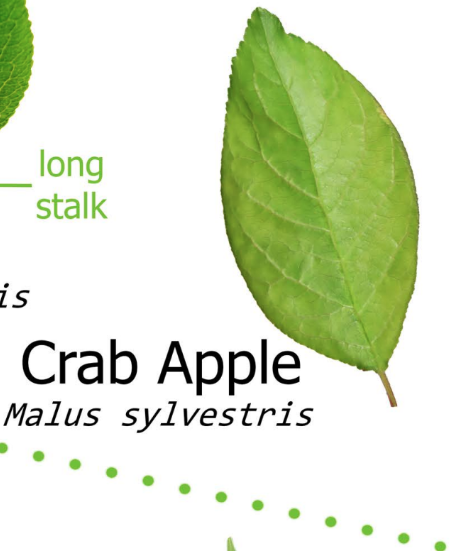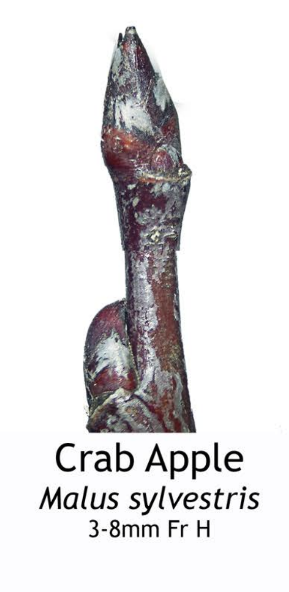A native deciduous tree species in Ireland, typically found in woodlands, hedgerows, and scrublands.
Recognising the Crab Apple Tree:
-
Leaves: The leaves of the Crab Apple tree are alternate, oval-shaped, and finely toothed along the margins. They are dark green in colour and turn yellow to orange in autumn before falling.
-
Bark: The bark of the Crab Apple tree is smooth and greyish-brown when young, becoming rougher and darker with age. It often develops vertical fissures and peels in small patches.
-
Flowers: Crab Apple trees produce clusters of small, fragrant flowers in spring. The flowers vary in colour from white to pink and are attractive to pollinators such as bees and butterflies.
-
Fruit: After flowering, Crab Apple trees produce small, tart fruits known as crab apples. The fruits are typically green or red in color and are edible but sour. They are often used in culinary applications such as preserves, jellies, and cider.
-
Habitat: Crab Apple trees are commonly found in a variety of habitats, including woodlands, hedgerows, and scrublands. They prefer well-drained soils and are often associated with other broadleaf tree species.


5 Interesting Facts about the Crab Apple Tree:
-
Genetic Diversity: Crab Apple trees are known for their genetic diversity, with a wide range of fruit colours, sizes, and flavours. This diversity has contributed to the development of many cultivated apple varieties through selective breeding.
-
Historical Uses: Crab Apples have been cultivated for thousands of years for their fruits, which were used in culinary applications such as jams, jellies, and cider. They were also valued for their ornamental qualities and used in landscaping and garden design.
-
Wildlife Habitat: Crab Apple trees provide habitat and food for a variety of wildlife species. Birds feed on the fruits (crab apples), while insects pollinate the flowers and feed on the foliage. Mammals such as deer may also browse on the foliage.
-
Disease Resistance: Crab Apple trees exhibit natural resistance to certain pests and diseases, making them valuable as rootstocks for cultivated apple varieties. They are often used as grafting or budding understocks to impart disease resistance to cultivated apple trees.
-
Cultural Significance: In folklore and traditional medicine, Crab Apple trees have been associated with various superstitions and beliefs. In some cultures, the tree was thought to symbolise love, fertility, and protection, while in others, it was believed to have medicinal properties.
Uses of the Crab Apple Tree:
-
Culinary Uses: The fruits (crab apples) of Crab Apple trees are used in culinary applications such as preserves, jellies, and cider. They have a tart flavor and high pectin content, making them ideal for making jams and jellies. Crab apple cider is also popular in some regions.
-
Ornamental Planting: Crab Apple trees are planted for ornamental purposes in parks, gardens, and landscapes, particularly for their beautiful spring flowers and attractive autumn foliage. They are valued for their aesthetic appeal and ability to attract pollinators.
-
Wildlife Habitat: Crab Apple trees contribute to biodiversity by providing habitat and food for a variety of wildlife species. Their presence enhances habitat complexity and provides food, shelter, and nesting sites for birds, insects, and mammals, contributing to overall biodiversity in woodland and hedgerow ecosystems.
Contribution to Biodiversity:
-
Habitat Provider: Crab Apple trees create diverse micro-habitats that support a wide range of plant and animal species. Their presence enhances habitat complexity and provides food, shelter, and nesting sites for wildlife, contributing to overall biodiversity in woodland and hedgerow ecosystems.
-
Pollinator Support: The fragrant flowers of Crab Apple trees provide an important nectar and pollen source for pollinators such as bees and butterflies. This supports pollinator populations and contributes to the health of ecosystems.
-
Seed Dispersal: Birds that feed on the fruits (crab apples) of Crab Apple trees help disperse the seeds over a wide area through their droppings. This promotes the regeneration and spread of Crab Apple trees in natural habitats, contributing to the diversity and resilience of woodland and hedgerow ecosystems.
In summary, the Crab Apple tree is recognisable by its fragrant flowers, tart fruits, and toothed leaves. It holds cultural significance, provides valuable resources for wildlife, and contributes to biodiversity and ecosystem health in Ireland's woodlands and hedgerows. Additionally, it serves as an important food source for birds and other wildlife, supports pollinator populations, and enhances habitat complexity in natural ecosystems.
Images taken from the beautiful posters created by Phil Barnett and you can download these and/or purchase other great designs from his online shop.
